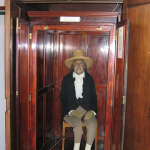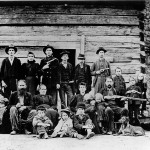Weekly Wrap Volume 92
 How Do They Get the “Ms” on “M&Ms”?
How Do They Get the “Ms” on “M&Ms”?
Most of us have probably wondered how each M&M is so perfectly marked with that signature white m. The production of the candy that “melts in your mouth and not in your hand” includes many different steps. First, the chocolate concoction is made and then poured into small round molds to form the cores of the M&Ms. These chocolatey centers are tumbled to create smooth circular surfaces, which will then be covered with a colorful liquid coating. Once the exterior liquid has dried to form the hard shell, each candy piece ends up held in an indentation on a conveyor belt that whisks them away to be stamped with the signature m. The actual process for applying each m is similar to the offset printing process. So, what is offset printing? Offset printing is widely used to produce high quality images on a variety of materials such… (more)
When it was released in 1960, Psycho was one of the most controversial films of the day, thanks in part to the surprising (for the time) depictions of violence and sexuality it contained. In an effort to keep spoilers to a minimum and thus ensure audiences were as surprised as possible by the film’s more shocking twists and scenes, Hitchcock went to some rather extreme lengths to keep the film’s basic plot a secret. For starters, one of the first things Hitchcock did after reading the original 1959 novel the film was based on- Psycho, by Robert Bloch- and deciding that he just had to adapt it to film, was charge his assistant with purchasing as many copies of the book as possible to keep it out of public hands. Exactly how many copies Hitchcock managed to get his hands on isn’t known, but it is generally thought that he came reasonably close to purchasing every copy on the shelves at the time. This must have been nice for Bloch, at least financially, who not only got a little over $9,000 (about $71,000 today) for the movie rights to the novel, but a nice payout for all the extra copies Hitchcock… (more)
 Are Fireman’s Poles Really a Thing?
Are Fireman’s Poles Really a Thing?
Fireman’s poles, sometimes simply referred to as “fire poles” are a staple of fictional fire-fighting and Ghostbusting. Though these devices have helped save real world firefighters valuable seconds over the decades, they’re now in a strange state of flux and nobody really knows if they’re going to be phased out or not. It’s reported that prior to the invention of the fire pole in 1878, most fire stations simply contained a set of stairs that firefighters would have to descend whenever an alarm rang. At this time, stairs in fire stations were almost always of the spiral variety, legend has it to stop curious horses from venturing upstairs and inevitably getting stuck. Of course, documented instances of this ever happening are seemingly non-existent as far as I can find, and the supposed problem could have easily been solved by simply tying up the horses or putting them in stalls, among other simple solutions. And, let’s face it, you don’t just let horses you might need at the ready at a moment’s notice wander around as they please, so it may well be that spiral staircases were… (more)
In the 2009 film, Avatar, the events of the film are set in motion by the desire to acquire a rare mineral of unfathomable value known simply as “unobtainium”. The unimaginative, seemingly lazy naming of this mysterious substance drew the ire and scorn of several critics, many of whom seemed blissfully unaware that aeronautical engineers and scientists have been talking about unobtainium since the 1950s. So what is unobtainium and who named it? Although it isn’t clear who first coined the term “unobtainium”, the first known documented case of it appeared in the February 27, 1956 edition of the Marshall, Michigan Evening Chronicle where it stated, “The metal is so hard to come by that the scientists have devised a lugubriously-humorous name for it. They… (more)
 The Interesting Journey of the Body of Famed Philosopher Jeremy Bentham
The Interesting Journey of the Body of Famed Philosopher Jeremy Bentham
Jeremy Bentham was born on February 15, 1748 in London, England. His father, a lawyer, believed Bentham would follow in his footsteps and enter the law profession. Due to his son’s very apparent intelligence, being something of an intellectual prodigy, he even had wild ambitions for Jeremy to ascend to the position of Lord Chancellor of England. And, indeed, Young Jeremy showed a propensity for learning at an early age, starting to learn Latin at the age of three and attending the Queen’s College Oxford at twelve. But after listening to leading law practitioners of the time, such as Sir William Blackstone, Bentham became disillusioned with the career path. So instead, he dedicated his life to writing about the inequities in law and proposing numerous social reforms- everything from advocating for a minimum wage, gay rights, universal suffrage, equal rights for women, ending slavery, separation of church and state, freedom of expression, the end of physical punishment (both concerning children and criminals), animal welfare, and ceasing capital punishment. In his spare time, he also was one of the founding fathers of… (more)
This Week’s YouTube Videos:
- The Dung Beetle and the Stars
- The Colosseum’s Big Brother, The Circus Maximus
- The Celestial Message in a Bottle
- When Will the Sun Die and 6 Other Space Facts
- “Swine Carcass” and 7 Other Language Facts
- The Greatest Practical Joke of the 19th Century
- The Bear Who Fought in WWII
Bonus Quick Facts:
- The ZIP code system was first introduced because the U.S. Postal Service was beginning to be overwhelmed with the volume of mail they needed to process in a timely manner, most of which was processed by hand at the time. However, only a few years after the ZIP code system was introduced in the 1960s, the Postal Service began using the MLOCR system for automatic sorting. Given the address, even without the ZIP code, the MLOCR system is almost always perfectly capable of assigning the ZIP+4 code to the address, with very little mail needing to be human-read to determine the correct address/ZIP code. So in most cases, including the ZIP or ZIP+4 code with the written address doesn’t really increase mail efficiency much at all anymore.
- Goldfish are one of many types of fish that will not stop eating if there is food available, regardless of how full they are. As such, overfeeding domesticated versions of the fish can easily kill them by blocking their intestines. This isn’t as much of a problem with certain types of wild goldfish, who have less complex intestinal tracts. In their case, when food is plentiful, they simply produce more waste.
- About four men will commit suicide for every one woman that does the same. Interestingly, despite this fact, nearly three times as many women as men will attempt to kill themselves.
- Harry Houdini’s real name was actually Erik Weisz. When his family immigrated to America, they changed the spelling to Ehrich Weiss, which eventually resulted in people calling him “Ehrie” and later “Harry”. He picked “Houdini” as his professional name in homage to the French magician Jean Eugène Robert-Houdin. He added the “i” because a friend of his, Jack Hayman, told him adding the “i” at the end would make it mean “like Houdin” in French, which of course isn’t correct, but nevertheless resulted in “Houdini”.
- The word “poop” comes from the onomatopoeia poupen or popen, which originally meant “fart”. “Poop” came into its current meaning around 1900.
- The primary reason cockroaches and many types of insects are so resistant to ionizing radiation is that their cells don’t divide that much between molting cycles. Cells are most susceptible to damage by ionizing radiation when they are dividing. Given that a typical cockroach only molts about once a week and its cells only divide around a 48 hour period during that week, about 3/4 of the cockroaches exposed would not be particularly susceptible to damage by ionizing radiation, at least, relative to those whose cells were currently dividing.
Other Interesting Stuff:
 Why Do They Use 21 Guns in the 21 Gun Salute?
Why Do They Use 21 Guns in the 21 Gun Salute?
The 21-gun salute that we know today has its roots in the ancient tradition of warriors demonstrating their peaceful intentions by resting the point of their weapons on the ground. The notion of making a soldier’s weapons useless to show that he came in peace continued even as warfare changed over the centuries. Gunpowder and cannons became commonplace among militaries and private forces, both on land and at sea around the 14th century. In order for a ship entering a foreign port to show those on shore that they came in peace, the captain would have his crew fire the guns. This rendered the weapons inoperable for a period of time… (more)
 The Richest Family in the World
The Richest Family in the World
Who was the wealthiest person in every century? That was a question we tried to answer in a previous TIFO article. While it was an incredibly difficult question to get definitive answers to, it did reveal that the wealthiest private entity in the 19th century was actually not a person – but a family. The Rothschild family, descendants of Mayer A. Rothschild, is still around today and is believed to be worth over a trillion dollars combined, thought to be the largest private fortunate in the history of the world. Who are the Rothschilds exactly and how did they amass this tremendous fortune? Mayer Amschel Rothschild, the patriarch of the Rothschild fortune, was born in 1744 in a Jewish ghetto in Frankfurt, Germany. When his father passed away, Mayer was still young, but he took over the family’s currency-exchange business. The work required Mayer to know a lot about different kinds of money, currency, and coins and, soon, he became an expert in rare and old coins. To supplement the business, he became a rare coins… (more)
 The High School Dropout Who Co-Created Trivial Pursuit
The High School Dropout Who Co-Created Trivial Pursuit
In December 1979, in the depths of a Montreal winter, two Canadian newspapermen created one of the most popular board games the world has ever known. High school dropout Chris Haney was the photo editor of The Gazette. He had originally dropped out of school at the age of 17 in order to take a copy boy job with the Canadian Press, the company his dad worked for. After his eventual Trivial Pursuit fame and riches, he would state he regretted his decision to drop out of school… at the age of 17; he stated he wished he’d done it at 12. (Incidentally, Dave Thomas, the founder of Wendy’s and the man partially responsible for saving KFC, was also a high school dropout.) In any event, Haney’s buddy, Scott Abbott, was the sports editor for The Canadian Press. According to legend, after realizing that a couple of tiles from the… (more)
 It’s “Just Deserts” Not “Just Desserts”
It’s “Just Deserts” Not “Just Desserts”
Today I found out that the idiom used for the notion of someone “getting what’s coming to them”, whether good or bad, is actually “just deserts”, not “just desserts”. The misconception primarily stems from the fact that most people are unfamiliar with the word ‘desert’ (pronounced dizert), which more or less means the same thing as the word ‘deserve’. Instead, when they see the word ‘desert’, most they think only of the word meaning something to the effect of ‘dry, sandy wasteland’, which is pronounced ‘dezert’. In fact, these two words that are spelled the same, but pronounced differently, have their origins in two different Latin words. The word ‘desert’, as in “sandy wasteland”, comes from the Latin word deserere, meaning… (more)
At their core, smoke alarms are very simple devices that need only two functions: a way of detecting smoke and a way of alerting people to the problem. From new technology involving lasers to old world technology that relies on a lonely individual sitting in a tower on the side of a mountain just waiting to see smoke, all do the same thing in different ways. The two most commonly used smoke alarms (mainly because they are inexpensive) are photoelectric and ionization detector alarms. The difference between the two lies in how they detect smoke particles. Depending on the conditions of the fire, one type is usually better than the other. Many other kinds of detectors exist that are more expensive and often situation specific (such as needing to protect classified documents or computer servers). These tend to be much… (more)
 The Real Feud Between the Hatfields and McCoys
The Real Feud Between the Hatfields and McCoys
As with a lot of historical events, Hollywood has glamorized and largely fictionalized the feud between the Hatfields and the McCoys. So what really happened? It is believed that both families came to America before it was even America. The Hatfields were among the first pioneers to make their way to this new land from the shores of Yorkshire in northern England. The first Hatfield was Matthias Heathfield, who settled in New Haven, Connecticut around 1660. It would seem that the name was slightly altered by Matthias’ descendents, either his children or grandchild, to forever be “Hatfields.” The McCoys came from Scotland, but would move to Ireland, before coming to the new world. The first known McCoy in America was John McCoy, who moved there with his wife (and possibly two brothers) in 1732 by way of Belfast, Ireland. With a 150… (more)
| Share the Knowledge! |
|







